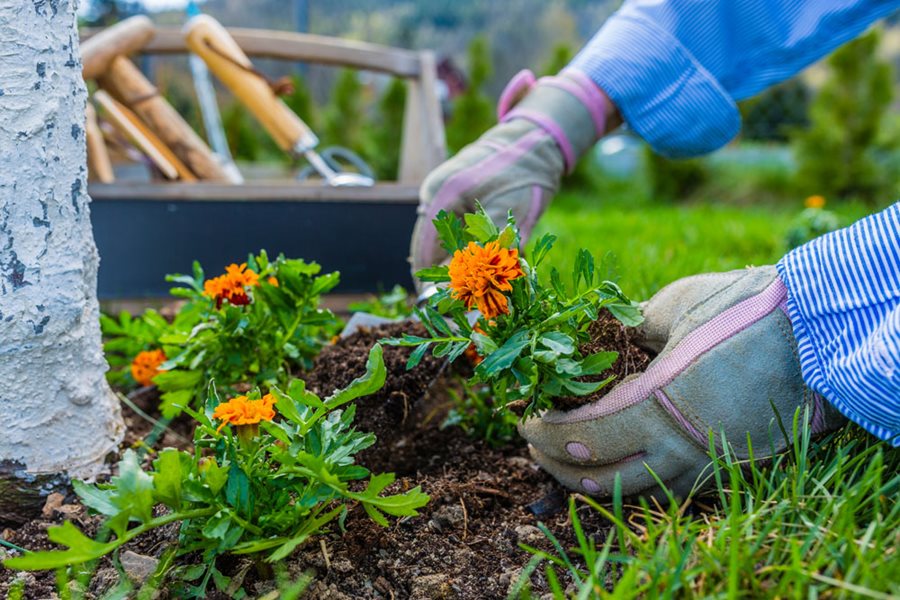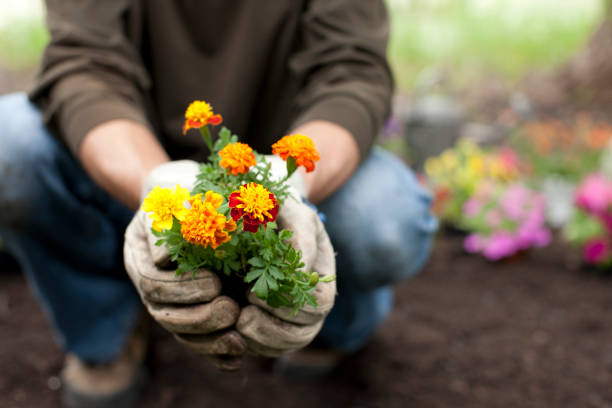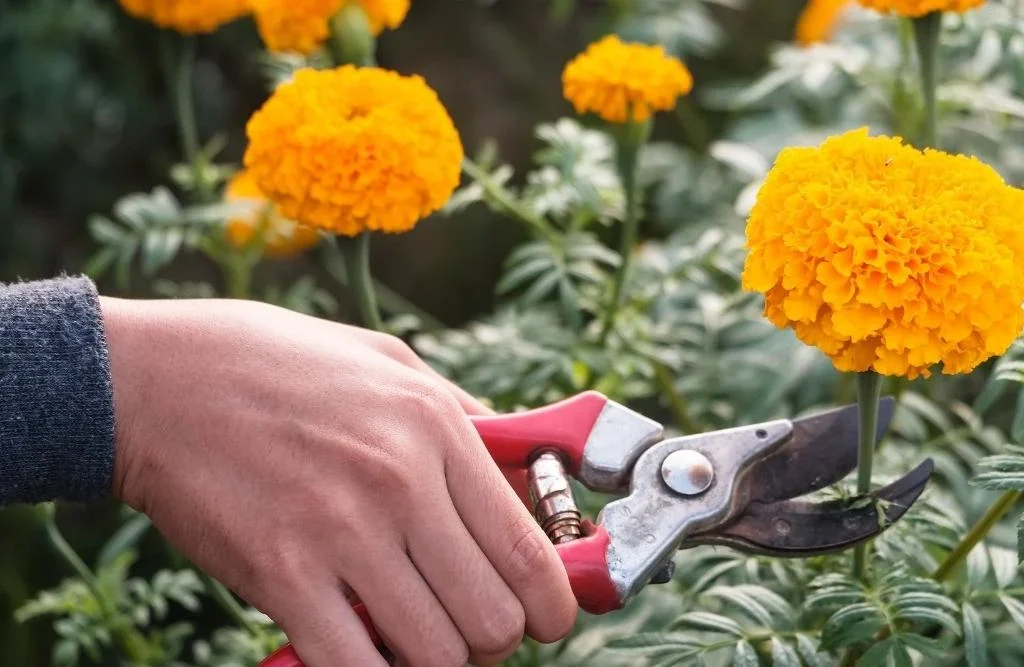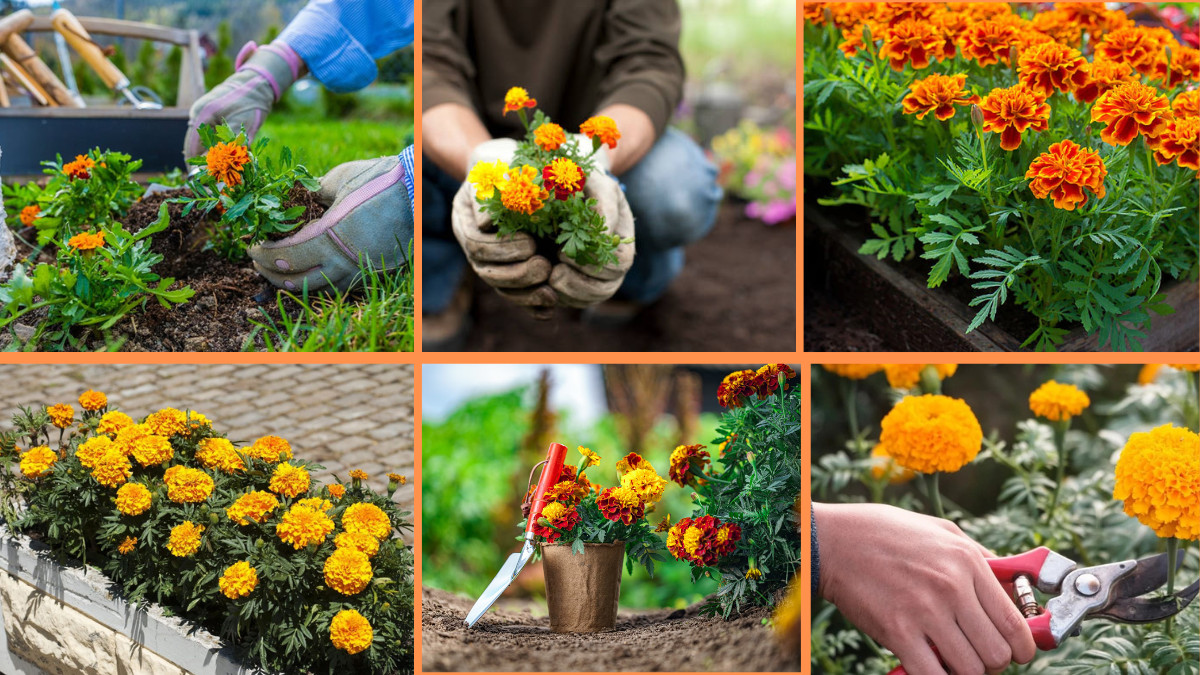If you’re looking for a cheerful, easy-to-grow flower that brightens up your garden while keeping pests at bay, marigolds are your perfect match. Known for their vibrant yellow, orange, and red hues, marigolds are not only beautiful but also beneficial to your garden’s ecosystem.
Whether you’re planting them in borders, flower beds, containers, or alongside vegetables, this guide will show you how to start growing marigolds successfully — from seed to full bloom.

Why Grow Marigolds?
Marigolds offer more than just good looks. Here’s why they’re a staple in both ornamental and vegetable gardens:
- Bright, Long-Lasting Blooms: Vibrant colors all summer long.
- Natural Pest Repellent: Deters nematodes, aphids, and even mosquitoes.
- Low Maintenance: Easy to grow and care for, even for beginners.
- Pollinator-Friendly: Attracts bees and beneficial insects.
- Versatile Uses: Great for borders, flower beds, pots, and vegetable companion planting.
Fun fact: In many cultures, marigolds symbolize warmth, creativity, and positivity, making them a popular flower for festive decorations.
Popular Marigold Varieties to Grow
Before planting, it’s helpful to know the different types of marigolds you can choose from:
| Type | Features | Best For |
|---|---|---|
| French Marigolds (Tagetes patula) | Small, bushy plants with single or double blooms | Borders, containers |
| African Marigolds (Tagetes erecta) | Large, pom-pom flowers on tall stems | Flower beds, back borders |
| Signet Marigolds (Tagetes tenuifolia) | Delicate, edible flowers with fine foliage | Edging, herb gardens |
Tip:
If you’re a beginner, start with French marigolds — they’re hardy, bloom prolifically, and thrive in most climates.

Best Time to Plant Marigolds
Marigolds thrive in warm weather. The best planting times are:
- Sow seeds indoors: 4-6 weeks before the last expected frost.
- Direct sow outdoors: After the danger of frost has passed and the soil is warm (typically late spring).
Note:
Marigolds grow quickly — expect blooms 45-60 days after sowing.
Choosing the Perfect Spot
Marigolds love the sun and will reward you with more blooms the sunnier the location. Here’s what they need:
- Full Sun: At least 6-8 hours of direct sunlight daily.
- Well-Draining Soil: While they’re tolerant of poor soils, good drainage ensures healthier plants and abundant flowers.
Ideal Soil pH:
6.0 to 7.5 — slightly acidic to neutral.

How to Prepare the Soil
To get your marigolds off to a strong start:
- Loosen the soil to a depth of 8-10 inches.
- Mix in some compost or aged manure to enrich poor soils.
- If planting in containers, use a well-draining potting mix.
Pro Tip:
Avoid overly rich, nitrogen-heavy soil — it promotes foliage growth at the expense of blooms.
How to Plant Marigolds
Starting from Seeds
- Sow seeds ¼ inch deep in seed-starting trays or directly in garden soil.
- Water gently and keep the soil moist but not soggy.
- Place seed trays in a warm spot (70–75°F or 21–24°C).
- Germination takes 5-7 days.
Once seedlings have two sets of true leaves, transplant them outdoors 12 inches apart for French marigolds and 18 inches apart for African marigolds.
Planting Nursery Starts
- Dig a hole twice the size of the nursery pot.
- Place the plant at the same depth it was growing in the pot.
- Backfill, firm gently, and water well.
Container Tip:
Use pots with drainage holes and avoid overwatering.
Watering and Feeding Marigolds
Marigolds are drought-tolerant once established but need regular watering while young.
- Water deeply when the top inch of soil feels dry.
- Avoid overhead watering to prevent fungal diseases.
- Fertilizing isn’t necessary in rich soils, but if desired, use a balanced, slow-release fertilizer once or twice during the growing season.
Avoid over-fertilizing — too much nitrogen reduces flowering.

Deadheading for More Blooms
To encourage continuous flowering:
- Regularly remove spent blooms (deadheading).
- Pinch or cut off faded flowers just above a leaf node.
- This promotes new buds and keeps the plant tidy.
Companion Planting with Marigolds
Marigolds are famous for their natural pest-repelling abilities. Plant them alongside:
- Tomatoes: Repels nematodes and aphids.
- Cucumbers: Deters beetles.
- Peppers: Protects against aphids and whiteflies.
- Squash: Keeps squash bugs at bay.
Pro Tip:
For maximum effect, plant a border of marigolds around your vegetable garden.

Common Marigold Problems and Solutions
Though hardy, marigolds can occasionally run into a few issues:
| Problem | Cause | Solution |
|---|---|---|
| Powdery Mildew | High humidity, poor air circulation | Space plants properly, water at soil level |
| Root Rot | Overwatering or poor drainage | Improve soil drainage, reduce watering |
| Aphids | Tiny sap-sucking insects | Spray with water or neem oil |
Generally, marigolds are pest-resistant and problem-free if cared for properly.
Collecting and Saving Marigold Seeds
Marigolds are easy to propagate from seed. To save seeds:
- Wait for flower heads to dry and turn brown.
- Snip off dried flower heads.
- Gently pull apart the seed head to release slender, black-and-white seeds.
- Store seeds in a cool, dry place in a paper envelope.
Next year’s blooms — sorted!

Enjoying and Using Marigolds
Marigolds offer both beauty and function in the garden. Use them for:
- Garden borders and edging pathways.
- Mixed container plantings for vibrant summer displays.
- Herbal and culinary uses: Signet marigold flowers are edible and add a citrusy note to salads.
- Natural pest control in vegetable gardens.
Fun Fact:
In many cultures, marigolds are used in religious ceremonies, weddings, and festivals for their symbolic meanings of prosperity and celebration.
Final Thoughts
If you’re searching for a garden flower that’s bright, low-maintenance, pest-resistant, and endlessly cheerful, marigolds are it. With just a little care, you’ll enjoy weeks of brilliant blooms and the added bonus of a healthier, happier garden ecosystem.
So grab a packet of seeds, pick a sunny spot, and let those golden, orange, and crimson flowers light up your outdoor space. Whether you’re a beginner or seasoned gardener, growing marigolds is pure garden joy!





